Ventotene, a guide to the Pontine Island
Our ultimate guide on what to see and what to do in Ventotene.
Ventotene is the smallest inhabited island of the Pontine archipelago and the smallest municipality of Lazio with its 743 inhabitants.
Named in the Odyssey as the Island of the Sirens and setting of the classic Italian comedy by Daniele Virzì, Ferie d'Agosto, Ventotene is a small jewel rich in history and ancient remains, with a sea and natural habitats among the most beautiful and exclusive of the Mediterranean.
The surface of the island is just 2 square kilometers and, a little less than a mile to the east, there is the small island of Santo Stefano, completely uninhabited and a destination for excursions and guided tours that can be experienced thanks to a cab boat service.
The seabed of the islet is a real paradise for divers who can admire red gorgonians and intertwining sea roses of a size hardly found elsewhere.
For those who seek close contact with nature without putting aside the discovery of a millennia-long history, the island of Ventotene is ideal.
The extraordinary morphology of the volcanic rocks, the colors and scents of the Mediterranean saltwater and the warm hospitality of the inhabitants of the island make Vontetene unforgettable.
Ventotene: from an Island of Exile to a Summer Getaway Spot
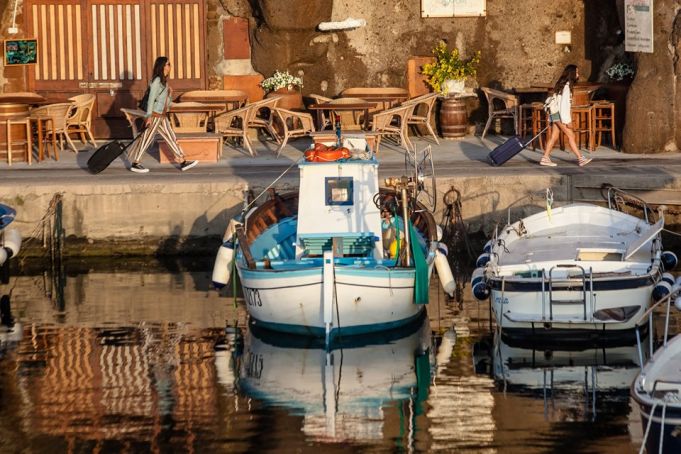
For various reasons, Agrippina Major, Livilla, Octavia and Flavia Domitilla were all confined on Ventotene. The island is also significant because it is here that was signed the Ventotene Manifesto that, in 1941, in the midst of World War II, called for the union of European countries and that will be the ideal reference to which many will look, in later years, for the process of continental integration.
Where is Ventotene?
Ventotene is the southernmost of the Pontine islands. Geographically, it is part of the Flegree Islands even if administratively it is part of the archipelago of the Ponziane Islands, in the province of Latina.
With the Flegree it shares the dark beaches and limestone tuffaceous rocks, and, in part, the culture: the inhabitants of Ventotene have origins from Campania and it can be heard in the dialect and tasted in the traditional cooking.
What to see in Ventotene
Santo Stefano Island
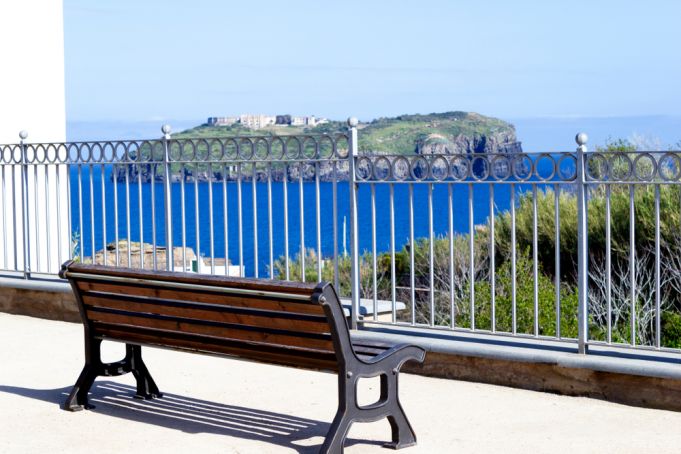
Ancient Roman Remains
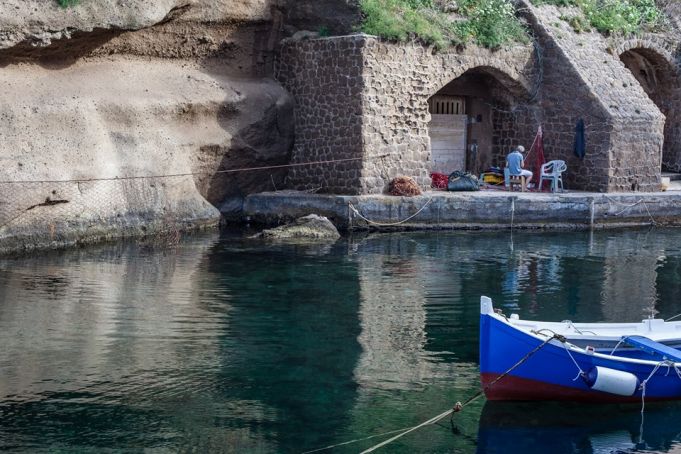
Grab a mask and snorkel and dive under the cliff of the lighthouse of Ventotene and you can still see the remains of Roman fish farms.
The Romans inhabited the island of Ventotene making it a fairly prosperous port.
Villa Giulia
Octavian Augustus had his villa built at a panoramic point of Ventotene, on Punta Eolo (the high land that juts out into the sea).
Today you can visit the baths of Villa Giulia and enjoy the magnificent view from the ruins. The Archaeological Museum of Ventotene organizes guided tours of Villa Giulia, though they must be booked in advance.
Roman cisterns of Ventotene
The Cisterna di Villa Stefania (Cistern of Villa Stefania) and the Cisterna dei Detenuti (Cistern of the Prisoners) are accessible by foot from Piazza Castello, the main square of the small town. Once you have reached the Cisterna dei Detenuti, you can view the murals and graffiti of daily life painted and engraved by prisoners who lived here during the Bourbon era (1734- 1860).
The Cistern of Villa Stefania is a perfect example of a rainwater supply system leftover from Ancient Rome: it is perfectly stuccoed and intact.
Island Views
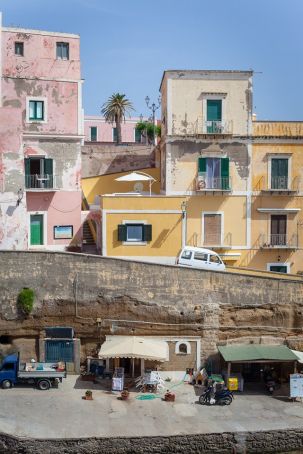
From this vantage point, you can also admire the sea. Along the coast, observe posidonias and seaweeds while, in the tidal pools, just below the surface of the water, you can spot: jellyfish, corals, gorgonians and actinias, molluscs, crustaceans, starfish and sea urchins. It is not uncommon to see evolutions of a small group of dolphins that frequent the waters of this sea and plunder the networks of fishermen along the reef called Moggio di Terra.
The waters are rich in squid, groupers, mullets, snappers, breams, mullets, amberjacks, turbot. The characteristics and the abundance of fish species and avifauna on the island have meant that in 1999 Ventotene was included, by the Ministry of Environment, among the Marine and Terrestrial Parks. Rich in beaches and coves, some reachable only by sea, the island also lives on tourism.
Among the typical products of the island there is the very precious Ventotene Lentil, as well known as the one from Castelluccio. The inhabitants serve it in soup with an abundant amount of basil and fish.
The Emerald and Turquoise Beaches of Ventotene
The coast of Ventotene is mostly rocky, however there are some beautiful beaches.
Cala Nave
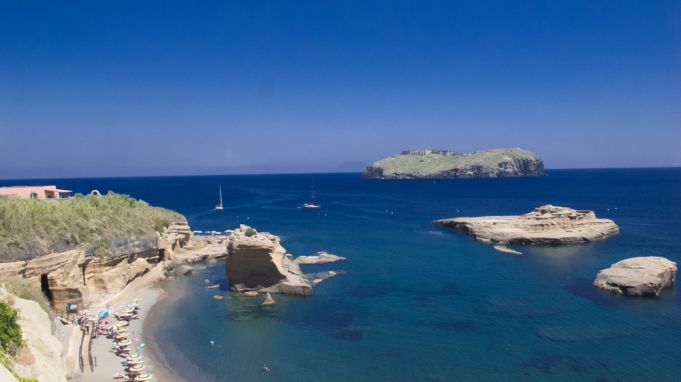
Lighthouse rocks
Adjacent to the small beach of Cala Nave the rocks of the lighthouse offer comfortable spaces to lie down, and trampolines of tuff perfect for diving. There is the possibility to rent sunbeds, or to lay in the sun directly on the rocks. Just below the lighthouse is a bar and restaurant where you can grab a drink and lunch.
Cala Rossano
Cala Rossano is small and can be reached on foot from the port. It is located just in front of the passage of boats and ferries and is not the most relaxing beach spot, but it can be an alternative to vary the routine of the island.
Punta Pascone
Ventotene and the beautiful, government protected marine reserve lend themselves particularly well to diving and snorkeling. Punta Pascone has a 15-meter seabed of black lava sand, populated by tracine and turbot.
Secca dell'Archetto is a shoal located about 300 meters from the coast of the island in the open sea. The underwater tunnel inhabited by sea sponges leaves you breathless.
How to get to Ventotene
Ventotene is an island that looks a bit like a raft in the middle of the sea. It is located halfway on the Ponza-Ischia route. The nearest port to Ventotene is the port of Formia which can be easily reached by car or by train from Rome (from Formia train station to the port is a short 10 minute walk). With the ferry it takes 2 hours to arrive from Formia, while with the high- speed hydrofoil the time is halved.
In addition to the port of Formia, ferries to Ventotene leave from the ports of Terracina and Anzio. Also, the islands of Ponza and Ventotene are connected by ferries.
Disembarkation fee
Those who arrive in Ventotene by ferry or dock at the port with a private boat are required to pay a landing fee of 1.50 euros. The tax is paid to reach the island, but not to return to the mainland.
As of 2018, even boats that moor in Ventotene waters are required to pay a fee, regardless of landing on land (information at the AMP-RNS Visitor Center tel. 077185239 e-mail: centrovisite@riservaventotene.it website: http://www.riservaventotene.it).
Where to Eat in Ventotene
Brigantino
Situated on the rocks below the lighthouse, this place is great for a first or second course, maybe for lunch with a sea view, in your bathing suit and with wet hair.
Address: Spiaggia Calanave. Phone: 0771 854041
Il Giardino
This restaurant offers a beautiful location, great service and simple but refined dishes.
Address: Via Olivi 45. Phone: 0771 85020
L'Isola dei Sapori
Located directly on the Porto Romano, this cafè prepares a delicious menu for an aperitif or light dinner.
Address: Via Porto Romano 3. Phone: 0771 85292
From the port you can get to the center by climbing the magnificent yellow zig-zag staircase. The island is easily navigated by foot. On the opposite side of the harbor the streets are not well lit, and in an evening walk illuminated by moonlight and starry skies is beautiful.
At times, the silence is only interrupted by the sound of the surf. If you visit in May you will find the island full of flowers and plants that fill the air: depending on the roads that travel there will be different scents to keep you company. The inlets, the landscapes, the colors of the sky and the sea make Ventotene fabulous.
General Info
View on Map
Ventotene, a guide to the Pontine Island
Ventotene Island, Italy

















